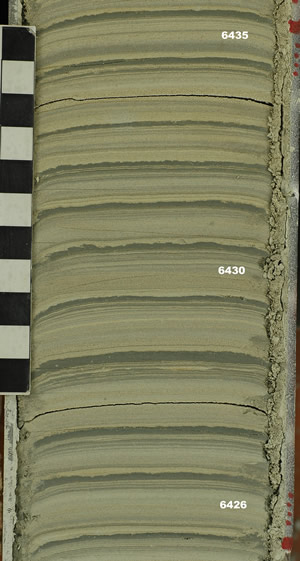Varves of the Month for 8/1/2008 - 8/31/2008
Connecticut Valley Varves at Aldrich Brook, Westmoreland, New Hampshire
This image shows ice-distal varves from the Connecticut Valley of southern New Hampshire. The summer or melt season layers (light, lower part of each annual layer) of three varves in the sequence are labeled for New England varves 6426-6435 (lower Connecticut varve sequence, New England Varve Chronology numbering system of Antevs, 1922). These varves were deposited about 500-550 years after ice recession at Aldrich Brook, when the receding ice margin was about 90-100 km away between Hanover and Lyme, New Hampshire. The pattern of sedimentation was complex, being controlled by both glacial and non-glacial (meteoric) processes. Varve thickness was largely controlled by glacial meltwater activity as meltwater moved south away from the glacier but most of the sediment in the varves shown here may have been entrained by glacial meltwater from local tributaries that were non-glacial at the time of varve deposition. The varves shown here are much thinner than varves lower in the sequence that were deposited when the receding ice front was much closer and more of the sediment was derived from a glacial source.
Summer or melt season layers (light-colored units) are composed of a stack of micrograded units of fine sand and silt. Many of the varves have sandy (lighter) layers marking the beginning (bottom) of each summer layer (see 6426-6428 and 6431-6433). The coarse layers that begin most summers are the result of rapid meltwater release from the glacier and adjacent land surface in the early summer, perhaps assisted by lake overturning during the main summer melting event. Occasionally there are relatively thick fine sand layers within the summer layers (see 6428, 6430, and 6434 for example) that represent the influx of sandy sediment from tributaries during rainstorm or land surface snowmelt events. The upper parts of most summer layers have a slightly grayer appearance reflective of more clay and silt vs. sandy tanner units below. Summer layers also appear to grade into their overlying winter layers. Gradation from summer to winter is reflected in the many fine sand and silt partings that interbed with clay in the bottoms of winter layers suggesting that clay deposition is initiated before the close of the melting season when melting or rainstorm events can still disperse coarser sediment to the lake floor. The highly rhythmic nature of the interbedding winter and summer units in some cases (see 6425-6430) is suggestive of diurnal variations in deposition at the close of the melting season. Summer layer thickness in this sequence is much greater than winter layer thickness and also varies much more than winter layer thickness. In this image summer and winter layer thicknesses appear to vary proportionally with the thickest summer layer (6428) overlain by the thickest winter layer and the thinnest summer layer (6433) overlain by the thinnest winter layer.
The Aldrich Brook section is a very important varve sequence to the New England Varve Chronology in that it is the foundation of the closure of the Claremont Gap in Antevs' (1922) original varve chronology. For more on the closure of the Claremont Gap go to the following links: New England Varve Chronology: Claremont Gap Closure and NEVC Today.
Past Varves of the Month...
- 6/1/2008 - Connecticut Valley Varves at Canoe Brook, Dummerston, Vermont
- 4/27/2008 - Connecticut Valley Varves from Kelsey Ferguson Brickyard, Redland Brick Co., East Windsor, Connecticut.
- 7/1/2008 - Champlain Valley varves at Keesville, NY
- 9/1/2008 - Connecticut Valley Varves, Perry Hill Basin (PHS), Charlestown, New Hampshire
- 10/1/2008 - Connecticut Valley Varves, Perry Hill Basin (PHN), Charlestown, New Hampshire.
- 11/1/2008 - Connecticut Valley Varves, Aldrich Brook site, Westmoreland, New Hampshire
- 12/1/2008 - Connecticut Valley Varves, Aldrich Brook site, Westmoreland, New Hampshire
- 1/1/2009 - Mine fire reclamation site, Olyphant, Pennsylvania
- 2/1/2009 - Connecticut Valley Varves, Perry Hill Basin (PHS), Charlestown, New Hampshire
- 3/1/2009 - Connecticut Valley Varves, Perry Hill Basin, Charlestown, New Hampshire
- 4/1/2009 - Connecticut Valley Varves, Perry Hill Basin, Charlestown, New Hampshire.
- 5/1/2009 - Connecticut Valley Varves, Perry Hill Basin, Charlestown, New Hampshire
- 6/1/2009 - Connecticut Valley Varves, Perry Hill Basin, Charlestown, New Hampshire
- 7/1/2009 - Connecticut Valley Varves, Perry Hill Basin, Charlestown, New Hampshire
- 8/1/2009 - Connecticut Valley Varves, Perry Hill Basin, Charlestown, New Hampshire
- 9/1/2009 - Connecticut Valley Varves, Perry Hill Basin, Charlestown, New Hampshire
- 10/1/2009 - Connecticut Valley Varves, Perry Hill Basin, Charlestown, New Hampshire
- 11/1/2009 - Connecticut Valley Varves, Perry Hill Basin, Charlestown, New Hampshire.
- 12/1/2009 - Connecticut Valley Varves, Perry Hill Basin, Charlestown, New Hampshire
- 1/1/2010 - Connecticut Valley Varves, Perry Hill Basin, Charlestown, New Hampshire
- 2/1/2010 - Varves along Starrucca Creek near Lanesboro, Pennsylvania
- 3/1/2010 - Varves in the Don Valley, Toronto
- 4/1/2010 - Varves along Sandy Stream, Dennistown Plantation near Jackman, Maine
- 5/3/2010 - Varves from Glacial Lake Great Falls in Montana
- 6/4/2010 - Varves from Charlestown, NH
- 7/1/2010 - Varves from Redlands Brick Co. (Kelsey Ferguson Brickyard, South Windsor, Connecticut) - A varve that Antevs missed
- 8/1/2010 - Varves from Glastonbury, Connecticut
- 9/1/2010 - Varves from North Hatfield, Massachusetts
- 10/1/2010 - Varves from Newbury, Vermont
- 11/1/2010 - Varves from Newbury, Vermont
- 12/1/2010 - Varves from Newbury, Vermont
- 2/1/2011 - Connecticut Valley Varves at North Hatfield, Massachusetts
- 3/1/2011 - Connecticut Valley Varves Kelsey Ferguson (Redlands Brick Co.), South Windsor, Connecticut
- 6/1/2011 - Connecticut Valley Varves: Core at Scantic, East Windsor, Connecticut
- 8/1/2011 - Varves of West Canada Creek Valley, western Mohawk Valley
- 10/1/2011 - Varves of West Canada Creek Valley, western Mohawk Valley collected in Newport, NY
- 12/1/2011 - Connecticut Valley Varves at Claremont Junction, NH
- 3/1/2012 - Connecticut Valley Varves at Westmoreland, NH
- 7/1/2012 - Connecticut Valley Varves at Rt. 12A drill site in North Charlestown, N.H.



